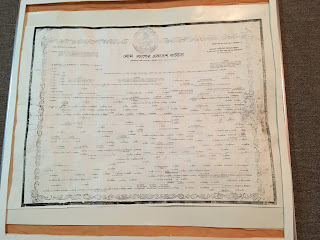Sample Pictures from Partition Documentation Museum, New York
ISPaD: Indian Subcontinent Partition Documentation Project
New York
Bricks -- discarded on site -- from ancient 2nd Millennia Buddhist Vihar in Comilla, Bangladesh; 1st Millennia Buddhist Vihar, Taxila, Pakistan; destroyed Hindu temples (1990s) in Bangladesh
The one item carried by a young Mr. Nirnal Guha Thakuarta, a native of Barisal, East Pakistan now Bangladesh, as he fled on foot and ferry to West Bengal after Partition.
(He became a music director in India.)
Courtesy: Mr. Guha Thakurta
(He became a music director in India.)
Courtesy: Mr. Guha Thakurta
Soils of villages of Lakhsmankathi in Barisal district, Mahilara in Barisal district, and Ulpur in Goplaganj (formerly Faridpur) district, all of East Pakistan, now Bangladesh brought by indigenous Hindus who fled to India.
Hand written notes of family tree of pre-1947 partition Hindu family of East Bengal, later refugee in India
A hand written, fragile, multi-page note of refugee family history, perhaps hundreds of years old, given by a Hindu-Bengali refugee to ISPaD Partition Museum
Lokkhir Jhapi (Lord Lakshmi's Basket), a symbol of Goddess of Prosperity, carried by new brides when first entering groom's home. It assumes that new brides bring prosperity to groom's family. This basket was handed down from mother to daughter for many generations in a Hindu family in east Bengal, now Bangladesh. This was one of the few items that a Bengali Hindu refugee family was able to bring to their new home in India (from Pakistan.)
Letter dated 17th September 1920 sent to Sreemati Nihar Ghosh, Student, Donovan Girls' High School, Madaripur, Bengal (now in Bangladesh) by the Governor's Office in British India for standing first in provincial exam. Ghosh became refugee from her ancestral home after 1947 Partition.
The letter writes:
Dear Madam: His Excellency is very glad to hear your success. Yours faithfully.....
Courtesy: Dr. Sankar Ghosh Dastidar
A traditional hookah carried from his village by a refugee.
A Treasure Chest (c) 1800s of a Hindu Refugee family from East Bengal/Bangladesh. One of the few items the family was able to bring to India.
Treasure Chest
Treasure Chest
Ghosh Bongsher Karika (Ghosh Family Chart) : This is a chart of almost 40 generations of Hindu Ghoshes of East Bengal, now Bangladesh. The chart goes back to many centuries - almost to First Millennium - before any of their neighbors took to Islam. Yet the 1947 partition drove almost all of them to India.
Banglar BrahmanKayastha O GhoshDastidar Bangsha (Bengal's Bramin-Kayastha and Ghosh Dastidar Family) by SriDskshinaRanjan GhoshDastidar, printed by SriSudhanghuRanjan Sengupta, Truth Press, 3 Nandan Road, Bhabanipur; Baisakh 1351 (April-May 1945). Price only 2 takas.
Sample page of 30 generational of history of Basu-Roy-Choudhury Family of Ulpur, Bangladesh. All most all the families became homeless refugee in India after India/Bengal Partition in 1947
Courtesy: Mrs. Pratima Roy Choudhury
Sample page of 30 generational of history of Basu-Roy-Choudhury Family of Ulpur, Bangladesh. All most all the families became homeless refugee in India after India/Bengal Partition in 1947
Book on Basu-Roy-Choudhury Family
Parichoy: Ulpur Basu-Roy-Chowdhury-r Bangsa Parochoy, authored by SriSatindraNath Roychoudhury, published on 30 Baisakh 1344 (April-May 1938)
Courtesy: Ulpur Association of Kolkata, India
Family Chart of Sen Family of Krittipasha, Barisal
but mostly live in India now, after partition.
A sample page of Bhattacharya family chart. Bhattacharyas are indigenous to Brahmanbaria, eastern Bangladesh. For tens of generations Bhattacharyas lived in Brahmanbaria but fled to vivisected Hindu-majority India after 1947 partition.
Courtesy: Mr. Jahar Bhattacharya
Khonar Bachan (Words of Lady Khona - a Hindu sage) written by SriDebendraNath Mitra, published by Unnayan Bibhag (Development Department), Government of Bengal (in British India; First Edition, Chaitra of 1352 BS; March-April 1946.) Introduction was written by S. M. Ishaq, Development Commissioner, Bengal. Words of Khona has influenced immensely the life of rural India, from planting of crops to home design to treatment of animals, plants and family members. (The book was priced 2 taka and 8 annas.)
Pre and Post-independence
Indian stamps
Bangladesh stamps issued by the Government-in-Exile during Bangladesh Liberation War, 1971
Bangladesh stamps issued in honor of American Bicentennial in 1976.
(U.S. government opposed Bangladesh Liberation, supported the genocidal army of Islamic Republic of Pakistan, and recognized Bangladesh many years after 1971. There was popular support for Liberation from the public though.)
A 1939 Property Deed of United Colonized British India.
The War of Independence 1857 conference - August of 2007 - poster of Peshawar University, Pakistan .
A Poster Reminding Atrocities of 1971.
It says:
Pakistan Terrorizing Force's Destruction of the Historic Ramna Kali Mandir (Temple) and Anadamoyee Ashram. Bangladesh
It Hasn't Been Rebuilt even after 26 Years (1997)
Ramna Kali Bari temple is one of the oldest Kali mandirs (temples) anywhere.
First Diwali Stamp of U.S.A.
Painting of a Calcutta Street Scene, 1700s, from Victoria Memorial Museum, Kolkata (Calcutta)
First Day Cover, free India honoring
Sri Aurobindo, 15-8-1964 (top)
and
Raja Ram Mohun Roy, 27-9-1964 (bottom)
First Day Cover, India, in Honor of Mahatma Gandhi, October 2, 1969






























1 comment:
This comment is far from being fueled by arrogant aspirations that popular aggrandizement of this link will be a factor in development of The ISPaD Project as a phenomenal NGO. Instead, this posting is written with an effort to compliment the difficult, intense, prolonged work that pieces like "Empire's Last Casualty" require. This comment is being written, AS WELL, as to make a polite extension of gratitude for this public paper of Dr. Dastidar's, as it complements much of The ISPaD (Indian Subcontinent Partition Documentation) Project's mission, effort, and work. There are truthful words being used, AFTER FAR TOO LONG, to educate the public about the issues, events, consequences, etc. surrounding Partition of the Indian Subcontinent.
Post a Comment